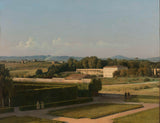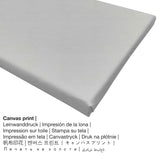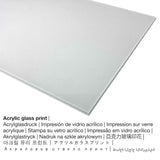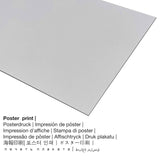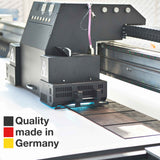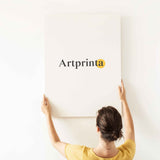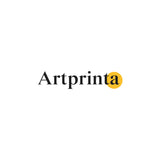Michel-Martin Drölling, 1811 - Echiche nke ubi nke Villa Medici - mbipụta nka mara mma
Ụtụ gụnyere. Mbupu gbakọrọ na ndenye ọpụpụ.
Kedu ihe ebipụta nka m nwere ike ịhọrọ?
In the product dropdown menu you can select your favorite size and material. In order match your personal requirements perfectly, you can choose among the following product customization options:
- Mbipụta kanvas: A printed canvas, which shall not be confused with an artwork painted on a canvas, is a digital copy printed directly on cotton canvas. Canvas Prints have the advantage of being relatively low in weight, meaning that it is quite simple to hang the Canvas print without additional wall-mounts. Canvas prints are suitable for all types of walls.
- Mbipụta aluminom (aluminium dibbond): These are metal prints on aluminium dibond with a true depth. A non-reflective surface structure make a contemporary look. The Aluminium Dibond Print is the excellent introduction to art replicas made with aluminum. For our Aluminium Dibond option, we print the favorite work of art right onto the aluminium white-primed surface. The bright parts of the artpiece shimmer with a silky gloss but without any glare. The print on Aluminum Dibond is the most popular entry-level product and is an extremely stylish way to display art reproductions, since it draws attention on the artwork.
- Mpempe akwụkwọ ederede (akwa akwa akwa): The Artprinta poster print is a printed canvas paper with a fine surface texture, that reminds the actual version of the masterpiece. Please keep in mind, that depending on the size of the poster we add a white margin of around 2 - 6cm round about the print motif, which facilitates the framing.
- Mbipụta iko acrylic (nke nwere ezigbo mkpuchi iko): An acrylic glass print, which is often labelled as a an art print on plexiglass, will turn your original work of art into wall décor and forms a great alternative option to canvas or aluminium dibond fine art replicas. The major advantage of an acrylic glass fine art copy is that contrasts and minor color details will be identifiable thanks to the granular tonal gradation.
Disclaimer: We try everything in order to describe the art products in as much detail as possible and to display them visually in our shop. Please keep in mind that the tone of the printed materials, as well as the print result may diverge to a certain extent from the presentation on your device's monitor. Depending on the screen settings and the condition of the surface, not all color pigments are printed 100% realistically. Bearing in mind that all the art reproductions are processed and printed by hand, there might also be slight differences in the motif's exact position and the size.
Nkọwa ndị ọzọ sitere na Rijksmuseum (© - Rijksmuseum - Rijksmuseum)
Drölling won the French Prix de Rome in 1810 and went to Rome the next year. He lived in the Villa Medici, which housed the French academy, where many Dutch artists also took drawing lessons. This view of the manor’s grand gardens, with the Villa Borghese in the distance, can still be seen today. Only the aqueduct was destroyed in 1843.
About the artwork painted by the modern artist named Michel-Martin Drölling
a 19th narị afọ nka nka View of the Gardens of Villa Medici mere site na nwoke artist Michel-Martin Drölling in the year 1811. E wezụga nke ahụ, a pụrụ ịhụ ihe osise a n'ime Rijksmuseum's digital art collection. We are pleased to mention that the masterpiece, which belongs to the public domain is supplied with courtesy of Rijksmuseum.The creditline of the artwork is the following: . Besides, the alignment of the digital reproduction is landscape and has a side ratio of 4: 3, nke pụtara na ogologo bụ 33% ogologo karịa obosara.
Data nka ahaziri
| Aha eserese ahụ: | "View of the Gardens of Villa Medici" |
| Nchịkọta nke ọrụ nka: | sere |
| Nhazi nka: | nkà nke oge a |
| Time: | 19th narị afọ |
| Year: | 1811 |
| Ogologo afọ nka nka: | ihe karịrị afọ 200 |
| Ụlọ ihe ngosi nka / mkpokọta: | Rijksmuseum |
| Ebe ngosi nka: | Amsterdam, Netherlands |
| Weebụsaịtị ihe ngosi nka: | Rijksmuseum |
| License: | ngalaba ọha |
| Site n'aka: | Rijksmuseum |
Ozi ihe ahaziri ahazi
| Bipụta ụdị ngwaahịa: | nka nka |
| Usoro mmeputakwa: | dijitalụ mmeputakwa |
| Usoro mmepụta: | Mbipụta UV ozugbo (mbipụta dijitalụ) |
| Ihe ngosi: | emepụtara na Germany |
| Stockdị ngwaahịa: | a na-achọ |
| Eji ngwaahịa a chọrọ: | ihe ndozi mgbidi, nka mgbidi |
| Nhazi: | usoro odida obodo |
| Oke akụkụ: | 4: 3 ogologo ruo obosara |
| Ntụgharị nkọwa akụkụ: | ogologo bụ 33% ogologo karịa obosara |
| Materials: | akwụkwọ mmado (akwụkwọ kwaaji), mbipụta enyo acrylic (nwere ezigbo mkpuchi iko), mbipụta akwa akwa, mbipụta ọla (aluminium dibbond) |
| Mpempe akwa akwa (akwa akwa na etiti ihe ndọtị) nha: | 40x30cm - 16x12", 80x60cm - 31x24", 120x90cm - 47x35", 160x120cm - 63x47" |
| Mpempe iko acrylic (nwere ezigbo mkpuchi iko) nha dị iche iche: | 40x30cm - 16x12", 80x60cm - 31x24", 120x90cm - 47x35" |
| Ụdị akwụkwọ mmado (akwụkwọ kwaaji) dị iche iche: | 40x30cm - 16x12", 80x60cm - 31x24", 120x90cm - 47x35" |
| Aluminom dibond ọdịdị nha ebipụta: | 40x30cm - 16x12", 80x60cm - 31x24", 120x90cm - 47x35" |
| Nhazi mbipụta nka: | mmeputakwa na-enweghị isi |
Nyocha ngwa ngwa nke onye na-ese ihe
| aha: | Michel-Martin Drölling |
| okike nke onye nka: | nwoke |
| Ọrụ: | onye na-ese ihe |
| Otu nka: | omenkà nke oge a |
Nwebiisinka © - Artprinta.com (Artprinta)

